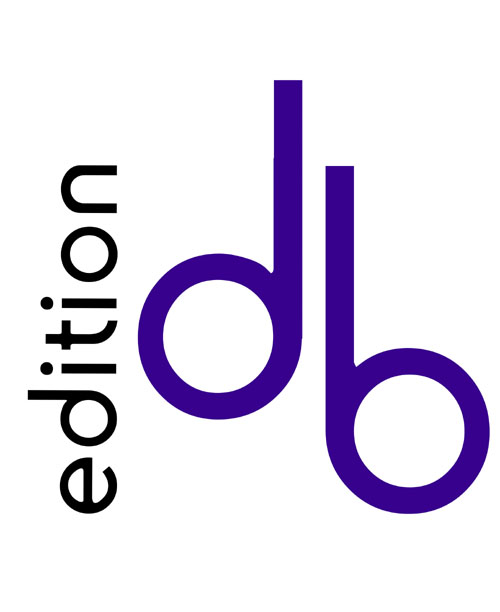
- 7 clarence grove
- horsforth
- leeds, LS18 4LA
- UK
- tel: 0113 258 1300
- order online
- order by fax
- www.editiondb.com
- 0113 258 2556
- info@editiondb.com
Review - Horn Sonata by Humphrey Procter-Gregg
edb PG01001 Procter-Gregg series
This substantial sonata of approximately eighteen minutes was written for and premiered by Robert Ashworth, principal horn of Opera North of Leeds, UK, who also recorded it in 2005 and has published the first edition from the new publishing house, edition db. According to biographical information supplied with the sonata, Humphrey Procter-Gregg (1895-1980) was an Emeritus Professor of Music at the University of Manchester as well as a prolific composer, and a biographer and friend of Sir Thomas Beecham.
This work is a very interesting addition to our sonata repertoire for a number of reasons. Written in 1975, it is a richly romantic composition for two equal collaborators, with tonal harmony, tunefulness, and predictable elements of form. The notes included indicate that Procter-Gregg loved the music of Delius, and his interest in the exploration of chromaticism is evident and intriguing. Moments are reminiscent of Wagner, late Strauss, and perhaps Karl Pilss. Another interesting aspect of this sonata is that its tessitura is strikingly low. The first movement includes only a couple of g”s, nd the second movement only one f#’, both movements using only a little over a total of two octaves. The last movement includes a couple of a”s and one b”. Somehow this conservative use use of range doesn’t seem to negatively affect the melodic material, which requires facility and good technique, in part because of the demanding keys (i.e. lots of sharps requiring the third valve), rapid key changes, and chromaticism.
The first movement, Andante mosso in a concert A major, is expressive and lyrical, driven by its chromatic colour, rhythmic motives, dynamic changes, the independence of the two parts and their alternations of dominance. The opening theme of the second movement is an engaging melody in f minor. In the program notes that he wrote, Procter-Gregg calls it “nostalgic”, referencing the closing line of Alfred de Vigny’s poem Le Cor, which describes the sound of the horn as sad. Because of the rate of harmonic change, the middle of this movement poses a special challenge in interpretation. The third movement, an Allegro, con spirito e giocoso, and – in Procter-Gregg’s words – “almost jocular”, is in a fugal style and calls to mind similarly energetic works like the Jacob Concerto, the Françaix Divertimento, or the final movement of the Gliere Concerto.
I believe this attractive sonata may become a popular recital piece, satisfying to both performers and audiences.
Virginia Thompson, The Horn Call, IHS, Vol XXXVII No.1, October 2006
_________________________________________________________________________________________________________________________________
Review - Horn Sonata by Humphrey Procter-Gregg
edb PG01001 Procter-Gregg series
With such a distinctive name, Humphrey Procter-Gregg (1895 - 1980) is easy to find on Google, but what the internet tells us reveals only a small part of his life. Mostly, googling produces references to his work as a translator of songs or opera libretti although there are a couple of mentions of his composition, Westmorland Sketches for solo piano. However, there is little about his efforts to establish opera in England in the years after the First World War or his friendship with Sir Thomas Beecham. Nor is there much about his subsequent change of career to become a lecturer at Manchester University, where he worked for nearly 30 years, ending up as the first Professor of Music there. During his time running the department his students included the group of composers known as the "Manchester School" - Birtwistle, Goehr, Howarth and Maxwell Davies - though it is well documented that Procter-Gregg and Maxwell Davies fell out badly. If one studies Procter-Gregg's Horn Sonata one can perhaps see why: the iconoclastic Maxwell Davies was hardly likely to appreciate the music of Procter-Gregg, a composer whose music is marinaded in the pastoral style of the 1920s and 30s - the so-called "cow-pat" school of writing - while to Procter-Gregg, the modernist aspirations of his student must have seemed like the air from another planet.
In common with his friend Beecham, Procter-Gregg was a great enthusiast for the music of Frederick Delius and this comes across clearly in the Horn Sonata. It is a three movement piece with a first movement which is shot through with Delian chromaticism and which its composer described as "cheerful and lyrical". The second movement is nostalgic and largely restrained and Procter-Gregg nods in the direction of academia by opening the finale with a fugal exposition. His use of this rigorous contrapuntal style is far from academic, however. As the composer himself put it, it is "almost jocular: it plays at solemnity in the middle, and ends in a burst of gaiety".
Procter-Gregg wrote the Sonata in 1975 for a concert to celebrate his own 80th birthday. The horn player on that occasion was RNCM student Bob Ashworth who, thirty years on, has now made the Sonata available through edition db, the publishing company he runs with his former colleague in the Opera North horn section, Dougie Scarfe. The Sonata is certainly not an easy piece to play as it makes use of the full range of the horn, and while the composer acknowledged that he had made concessions to problems "pneumatic and hydraulic" which he saw as besetting the horn, the work certainly requires stamina from both horn player and accompanist. Nevertheless, it is clearly a worthwhile addition to the repertoire and a piece which deserves to be heard.
John Humphries, The Horn Player, BHS, Vol.2, No.2, August 2005